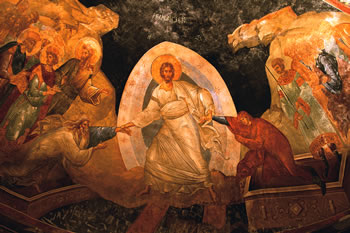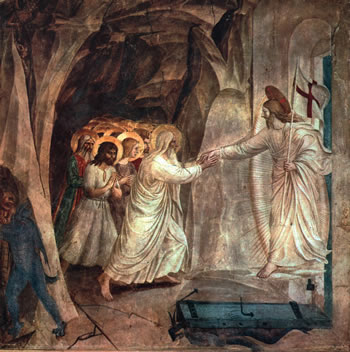Holy Saturday: The Harrowing of Hell
By the expression ‘He descended into Hell,’ the Apostles’ Creed confesses that Jesus did
really die and through his death for us conquered death and the devil ‘who has the power of death’ (Hebrews 2:14). In his human soul united to his divine person, the dead Christ went down to the realm of the dead. He opened Heaven’s gates for the just who had gone before him. Catechism of the Catholic Church, 636, 637
The frequent New Testament affirmations that Jesus was “raised from the dead” presuppose that the crucified one sojourned in the realm of the dead prior to his resurrection. This was the first meaning given in the apostolic preaching to Christ’s descent into hell: that Jesus, like all men, experienced death and in his soul joined the others in the realm of the dead. But he descended there as Saviour, proclaiming the Good News to the spirits imprisoned there. CCC 632
Scripture calls the abode of the dead, to which the dead Christ went down, ‘hell’ – Sheol in Hebrew or Hades in Greek - because those who are there are deprived of the vision of God. Such is the case for all the dead, whether evil or righteous, while they await the Redeemer. It is precisely these holy souls, who awaited their Saviour in Abraham’s bosom, whom Christ the Lord delivered when he descended into hell. CCC 633
The idea of the underworld developed about 5,000 years ago in Mesopotamia. The Jewish people adopted the idea and called the place where people went after death ‘Sheol.’ The Greeks called this place ‘Hades.’ It was a place where everything was drab, dreary and depressing. The inhabitants moved in monotonous slow motion and the mood was one of hopelessness.
The Fathers of the Church spoke about this underworld place on the other side of death. An ancient homily for Easter Sunday said to be the work of St John Chrysostom says:
Hades was embittered when it tasted of his flesh. It received a body, and it encountered God. It received earth, and came face to face with heaven. O death, where is thy sting? O Hades, where is thy victory?
The apocryphal Gospel of Nicodemus contains much material about the Lord’s descent into hell, telling of how the devil boasted to Hades that he had caused Christ to be killed. Hades realised instantly that his days were numbered. Having met Christ previously, he knew that Christ was far too powerful for him.
The harrowing of hell is to do with the time between Christ’s death and resurrection. Depictions of this event often show Christ standing on the smashed doors of the kingdom of hell, ruled by the prince of darkness. The Lord’s first action is to free Adam and Eve, whose sin had condemned the human race to pain and sorrow, from their graves. Following them come the ancient kings and prophets of Israel and John the Baptist.
These are scenes of the most astounding about-face conceivable. Death has been defeated forever. All those who had lived before Christ had been held in the power of death and have now been freed from death’s power.

This fresco is in the 11th century Church of the Holy Saviour in Chora, Istanbul. Christ is pictured saving Adam and Eve by dragging them from their coffins. Note that the Saviour pulls Adam and Eve by their wrists, a symbol of their inability to do anything for themselves – the work of saving is Christ’s alone. Behind Adam stand John the Baptist, David and Solomon.
Images of the harrowing of hell remind us that the cross is empty, that death doesn’t have the last word and that we need not be afraid of dying. Such images are also signs of forgiveness. Adam and Eve are forgiven, and so are we, if we want to be.
‘Perhaps that’s why the Byzantine Church loved the “harrowing of hell” story so much and used it as their resurrection story,’ Sheila Cassidy wrote in an article last year. ‘Easter Sunday for them was not just about weeping women around an empty tomb -- it was the day on which Christ triumphed over evil, defeated death. I look at the icons of Christ hauling Adam and Eve out of the tomb and kicking the instruments of torture into the abyss and I say to myself, wowie!’
References:
Pax Christi USA; Sheila Cassidy, "Good Friday People", pp 158 ff.; and the website of the Cathedral of the Immaculate Conception, Kansas City.


 Entries(RSS)
Entries(RSS)